PUBH6006 Group Report: Prevention of Obesity in Children and Youth
VerifiedAdded on 2022/10/01
|5
|1126
|12
Report
AI Summary
This report focuses on the prevention of obesity in children, addressing the issue from a community health perspective. It begins by emphasizing the role of various community members, including parents, schools, and public health officers, in managing childhood obesity. The report highlights the importance of assessing children's Body Mass Index (BMI) and BMI-for-age to determine their weight status. It then delves into strategies like changing family eating habits to promote healthier food choices and setting good examples for children. Furthermore, the report explores the evaluation of obesity prevention programs, including the recommendations for patient-level interventions, such as counseling on healthy eating and increased physical activity. The report provides recommendations at both patient and community levels, emphasizing the need for interventions like promoting healthy eating habits and increasing physical activity in schools. References to relevant studies are included to support the findings and recommendations.
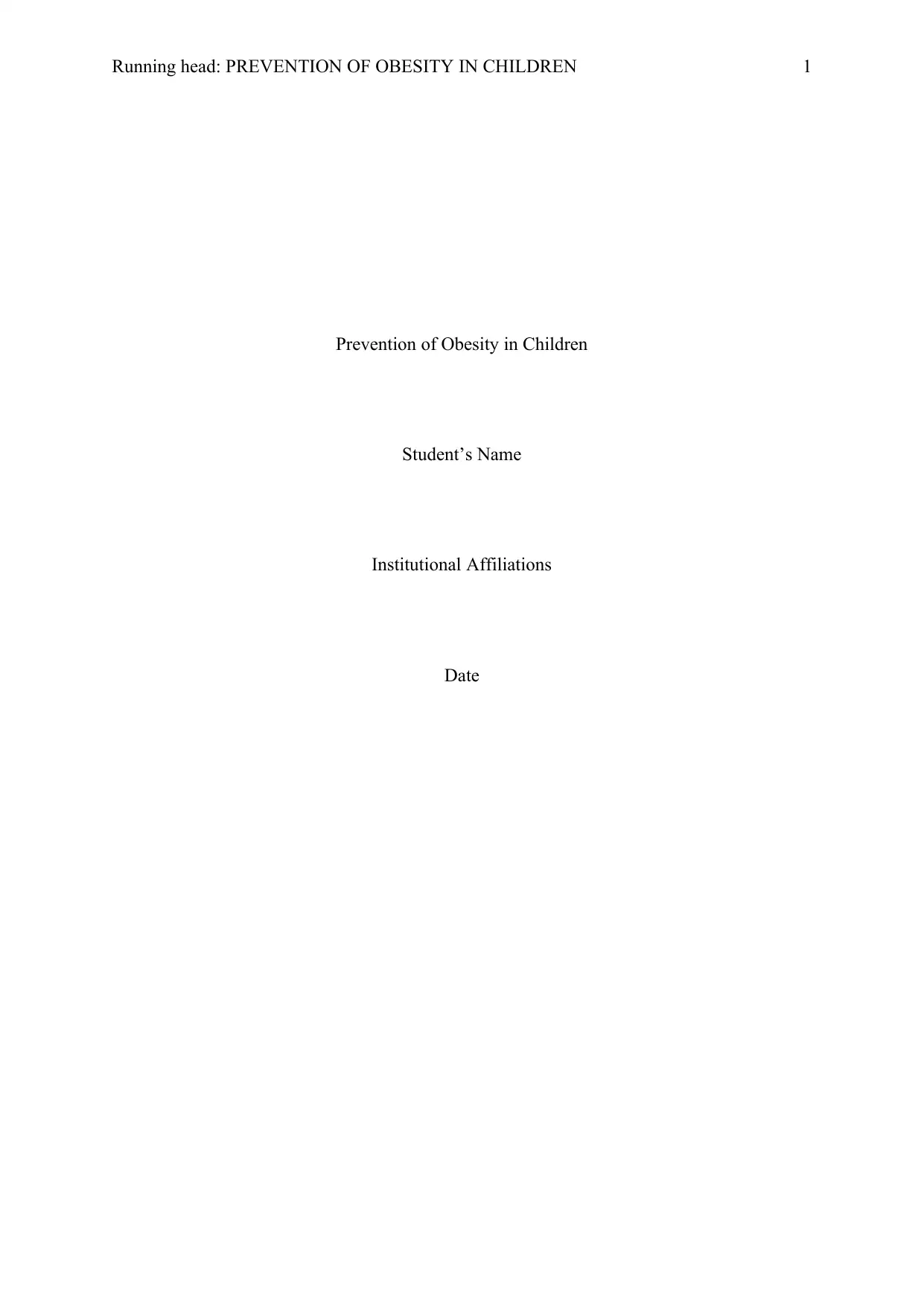
Running head: PREVENTION OF OBESITY IN CHILDREN 1
Prevention of Obesity in Children
Student’s Name
Institutional Affiliations
Date
Prevention of Obesity in Children
Student’s Name
Institutional Affiliations
Date
Paraphrase This Document
Need a fresh take? Get an instant paraphrase of this document with our AI Paraphraser
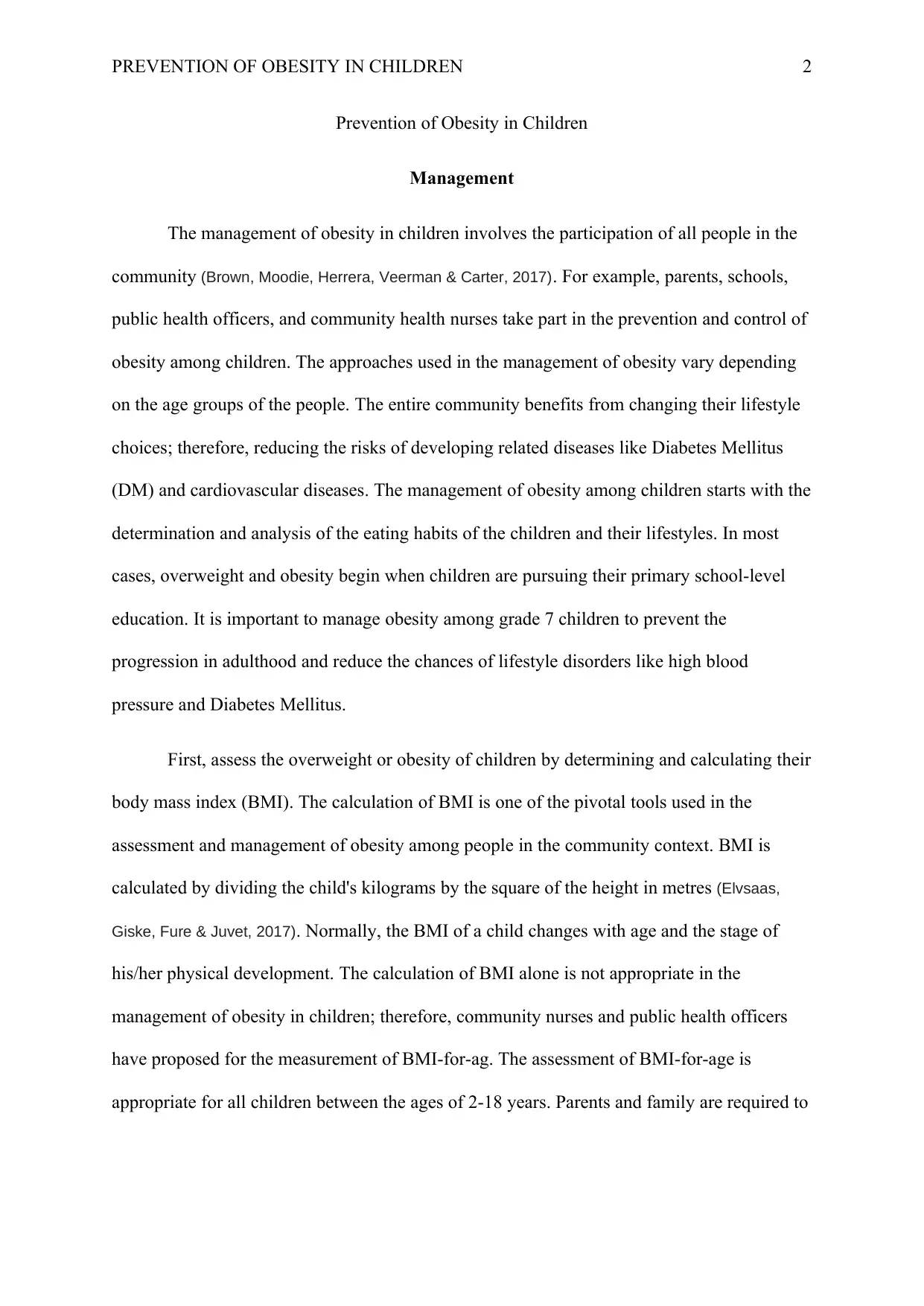
PREVENTION OF OBESITY IN CHILDREN 2
Prevention of Obesity in Children
Management
The management of obesity in children involves the participation of all people in the
community (Brown, Moodie, Herrera, Veerman & Carter, 2017). For example, parents, schools,
public health officers, and community health nurses take part in the prevention and control of
obesity among children. The approaches used in the management of obesity vary depending
on the age groups of the people. The entire community benefits from changing their lifestyle
choices; therefore, reducing the risks of developing related diseases like Diabetes Mellitus
(DM) and cardiovascular diseases. The management of obesity among children starts with the
determination and analysis of the eating habits of the children and their lifestyles. In most
cases, overweight and obesity begin when children are pursuing their primary school-level
education. It is important to manage obesity among grade 7 children to prevent the
progression in adulthood and reduce the chances of lifestyle disorders like high blood
pressure and Diabetes Mellitus.
First, assess the overweight or obesity of children by determining and calculating their
body mass index (BMI). The calculation of BMI is one of the pivotal tools used in the
assessment and management of obesity among people in the community context. BMI is
calculated by dividing the child's kilograms by the square of the height in metres (Elvsaas,
Giske, Fure & Juvet, 2017). Normally, the BMI of a child changes with age and the stage of
his/her physical development. The calculation of BMI alone is not appropriate in the
management of obesity in children; therefore, community nurses and public health officers
have proposed for the measurement of BMI-for-ag. The assessment of BMI-for-age is
appropriate for all children between the ages of 2-18 years. Parents and family are required to
Prevention of Obesity in Children
Management
The management of obesity in children involves the participation of all people in the
community (Brown, Moodie, Herrera, Veerman & Carter, 2017). For example, parents, schools,
public health officers, and community health nurses take part in the prevention and control of
obesity among children. The approaches used in the management of obesity vary depending
on the age groups of the people. The entire community benefits from changing their lifestyle
choices; therefore, reducing the risks of developing related diseases like Diabetes Mellitus
(DM) and cardiovascular diseases. The management of obesity among children starts with the
determination and analysis of the eating habits of the children and their lifestyles. In most
cases, overweight and obesity begin when children are pursuing their primary school-level
education. It is important to manage obesity among grade 7 children to prevent the
progression in adulthood and reduce the chances of lifestyle disorders like high blood
pressure and Diabetes Mellitus.
First, assess the overweight or obesity of children by determining and calculating their
body mass index (BMI). The calculation of BMI is one of the pivotal tools used in the
assessment and management of obesity among people in the community context. BMI is
calculated by dividing the child's kilograms by the square of the height in metres (Elvsaas,
Giske, Fure & Juvet, 2017). Normally, the BMI of a child changes with age and the stage of
his/her physical development. The calculation of BMI alone is not appropriate in the
management of obesity in children; therefore, community nurses and public health officers
have proposed for the measurement of BMI-for-ag. The assessment of BMI-for-age is
appropriate for all children between the ages of 2-18 years. Parents and family are required to
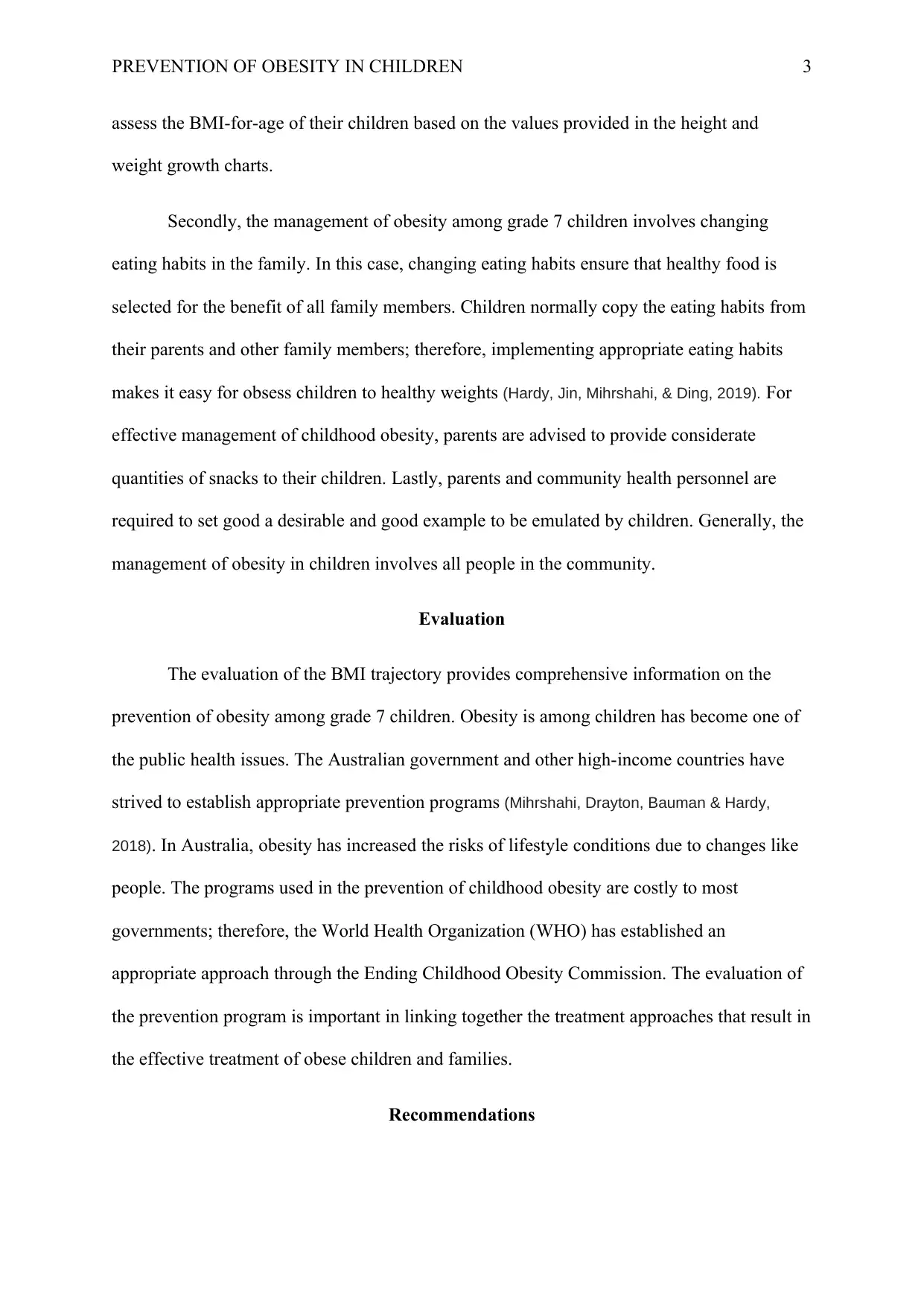
PREVENTION OF OBESITY IN CHILDREN 3
assess the BMI-for-age of their children based on the values provided in the height and
weight growth charts.
Secondly, the management of obesity among grade 7 children involves changing
eating habits in the family. In this case, changing eating habits ensure that healthy food is
selected for the benefit of all family members. Children normally copy the eating habits from
their parents and other family members; therefore, implementing appropriate eating habits
makes it easy for obsess children to healthy weights (Hardy, Jin, Mihrshahi, & Ding, 2019). For
effective management of childhood obesity, parents are advised to provide considerate
quantities of snacks to their children. Lastly, parents and community health personnel are
required to set good a desirable and good example to be emulated by children. Generally, the
management of obesity in children involves all people in the community.
Evaluation
The evaluation of the BMI trajectory provides comprehensive information on the
prevention of obesity among grade 7 children. Obesity is among children has become one of
the public health issues. The Australian government and other high-income countries have
strived to establish appropriate prevention programs (Mihrshahi, Drayton, Bauman & Hardy,
2018). In Australia, obesity has increased the risks of lifestyle conditions due to changes like
people. The programs used in the prevention of childhood obesity are costly to most
governments; therefore, the World Health Organization (WHO) has established an
appropriate approach through the Ending Childhood Obesity Commission. The evaluation of
the prevention program is important in linking together the treatment approaches that result in
the effective treatment of obese children and families.
Recommendations
assess the BMI-for-age of their children based on the values provided in the height and
weight growth charts.
Secondly, the management of obesity among grade 7 children involves changing
eating habits in the family. In this case, changing eating habits ensure that healthy food is
selected for the benefit of all family members. Children normally copy the eating habits from
their parents and other family members; therefore, implementing appropriate eating habits
makes it easy for obsess children to healthy weights (Hardy, Jin, Mihrshahi, & Ding, 2019). For
effective management of childhood obesity, parents are advised to provide considerate
quantities of snacks to their children. Lastly, parents and community health personnel are
required to set good a desirable and good example to be emulated by children. Generally, the
management of obesity in children involves all people in the community.
Evaluation
The evaluation of the BMI trajectory provides comprehensive information on the
prevention of obesity among grade 7 children. Obesity is among children has become one of
the public health issues. The Australian government and other high-income countries have
strived to establish appropriate prevention programs (Mihrshahi, Drayton, Bauman & Hardy,
2018). In Australia, obesity has increased the risks of lifestyle conditions due to changes like
people. The programs used in the prevention of childhood obesity are costly to most
governments; therefore, the World Health Organization (WHO) has established an
appropriate approach through the Ending Childhood Obesity Commission. The evaluation of
the prevention program is important in linking together the treatment approaches that result in
the effective treatment of obese children and families.
Recommendations
⊘ This is a preview!⊘
Do you want full access?
Subscribe today to unlock all pages.

Trusted by 1+ million students worldwide
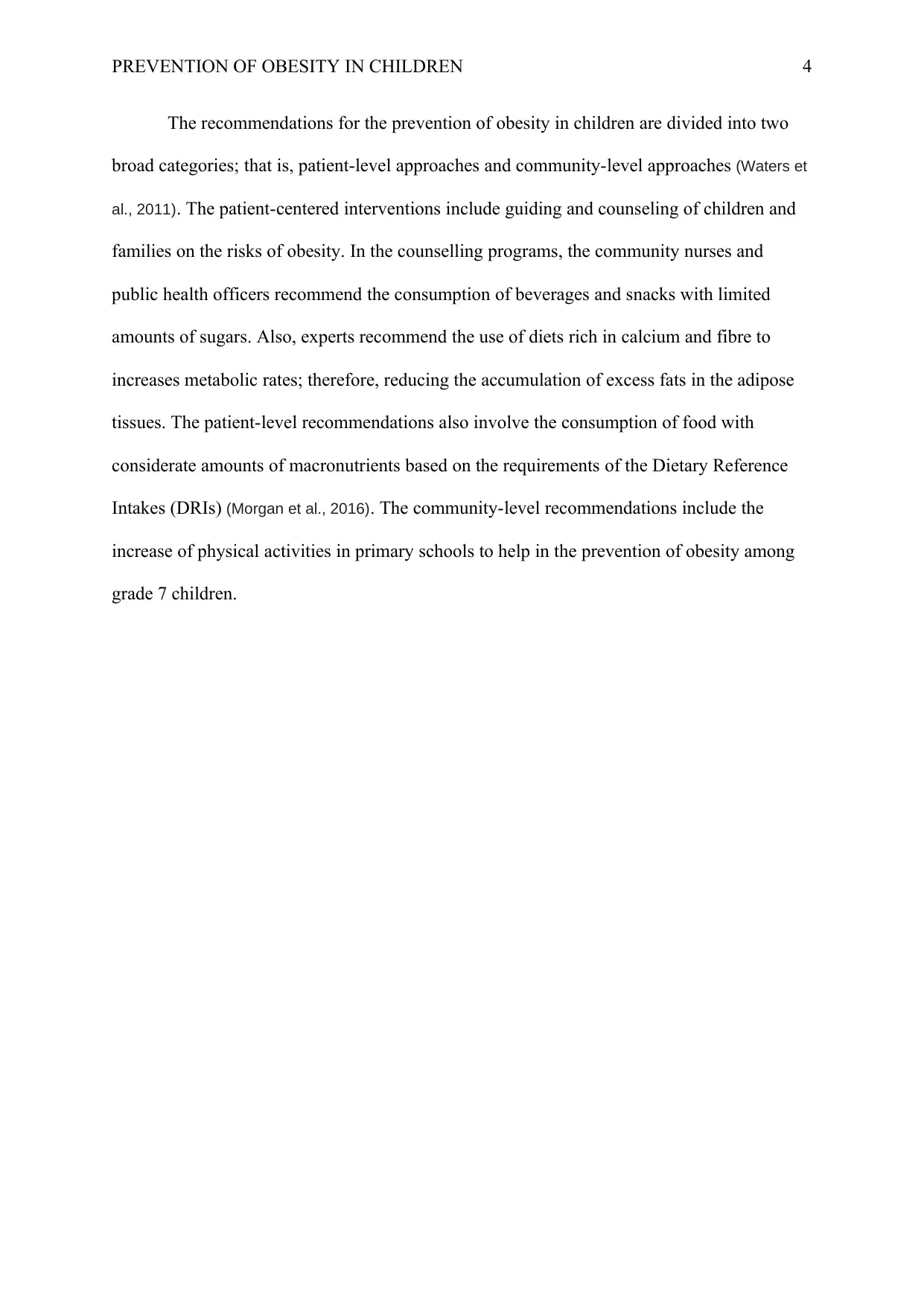
PREVENTION OF OBESITY IN CHILDREN 4
The recommendations for the prevention of obesity in children are divided into two
broad categories; that is, patient-level approaches and community-level approaches (Waters et
al., 2011). The patient-centered interventions include guiding and counseling of children and
families on the risks of obesity. In the counselling programs, the community nurses and
public health officers recommend the consumption of beverages and snacks with limited
amounts of sugars. Also, experts recommend the use of diets rich in calcium and fibre to
increases metabolic rates; therefore, reducing the accumulation of excess fats in the adipose
tissues. The patient-level recommendations also involve the consumption of food with
considerate amounts of macronutrients based on the requirements of the Dietary Reference
Intakes (DRIs) (Morgan et al., 2016). The community-level recommendations include the
increase of physical activities in primary schools to help in the prevention of obesity among
grade 7 children.
The recommendations for the prevention of obesity in children are divided into two
broad categories; that is, patient-level approaches and community-level approaches (Waters et
al., 2011). The patient-centered interventions include guiding and counseling of children and
families on the risks of obesity. In the counselling programs, the community nurses and
public health officers recommend the consumption of beverages and snacks with limited
amounts of sugars. Also, experts recommend the use of diets rich in calcium and fibre to
increases metabolic rates; therefore, reducing the accumulation of excess fats in the adipose
tissues. The patient-level recommendations also involve the consumption of food with
considerate amounts of macronutrients based on the requirements of the Dietary Reference
Intakes (DRIs) (Morgan et al., 2016). The community-level recommendations include the
increase of physical activities in primary schools to help in the prevention of obesity among
grade 7 children.
Paraphrase This Document
Need a fresh take? Get an instant paraphrase of this document with our AI Paraphraser
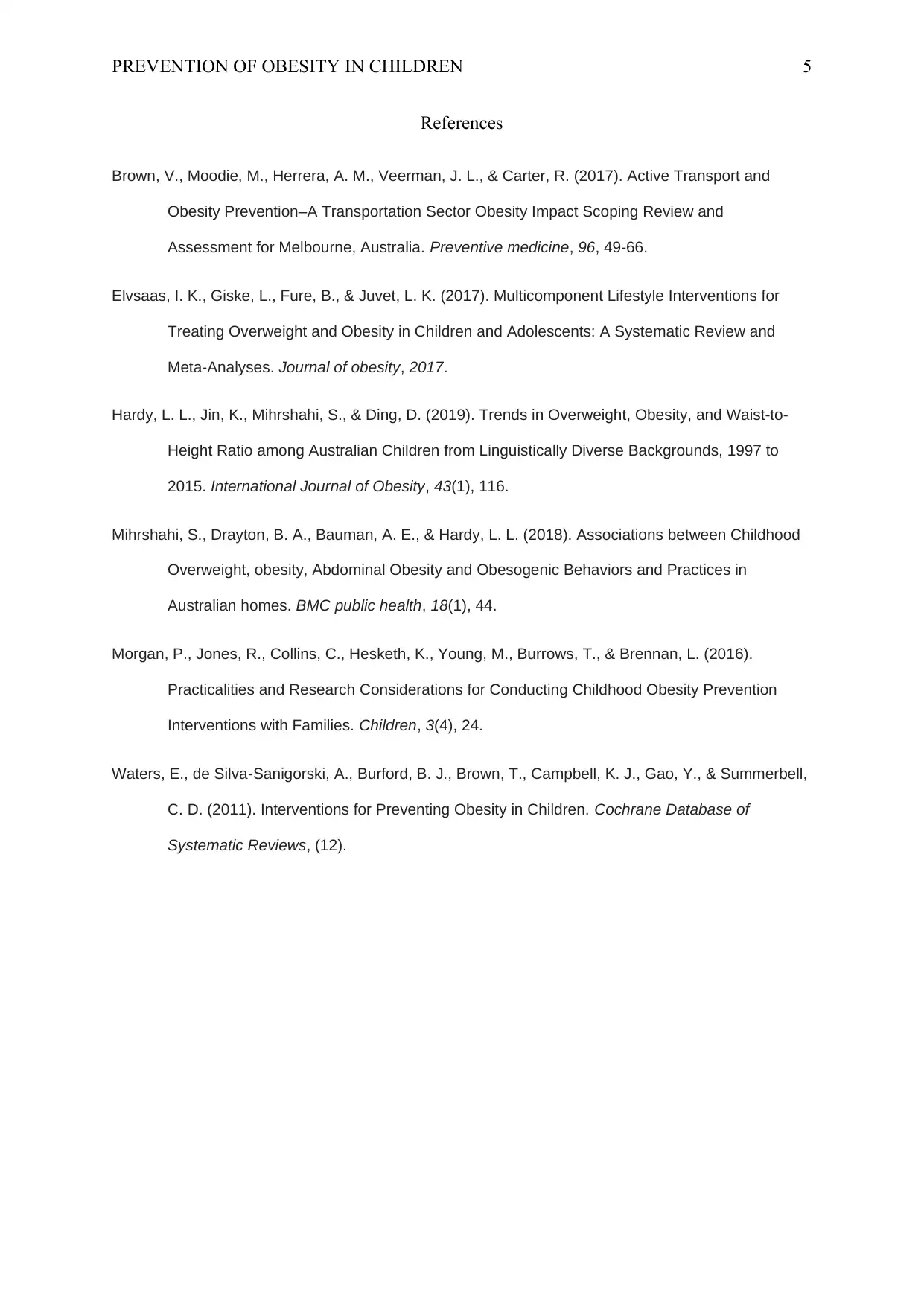
PREVENTION OF OBESITY IN CHILDREN 5
References
Brown, V., Moodie, M., Herrera, A. M., Veerman, J. L., & Carter, R. (2017). Active Transport and
Obesity Prevention–A Transportation Sector Obesity Impact Scoping Review and
Assessment for Melbourne, Australia. Preventive medicine, 96, 49-66.
Elvsaas, I. K., Giske, L., Fure, B., & Juvet, L. K. (2017). Multicomponent Lifestyle Interventions for
Treating Overweight and Obesity in Children and Adolescents: A Systematic Review and
Meta-Analyses. Journal of obesity, 2017.
Hardy, L. L., Jin, K., Mihrshahi, S., & Ding, D. (2019). Trends in Overweight, Obesity, and Waist-to-
Height Ratio among Australian Children from Linguistically Diverse Backgrounds, 1997 to
2015. International Journal of Obesity, 43(1), 116.
Mihrshahi, S., Drayton, B. A., Bauman, A. E., & Hardy, L. L. (2018). Associations between Childhood
Overweight, obesity, Abdominal Obesity and Obesogenic Behaviors and Practices in
Australian homes. BMC public health, 18(1), 44.
Morgan, P., Jones, R., Collins, C., Hesketh, K., Young, M., Burrows, T., & Brennan, L. (2016).
Practicalities and Research Considerations for Conducting Childhood Obesity Prevention
Interventions with Families. Children, 3(4), 24.
Waters, E., de Silva‐Sanigorski, A., Burford, B. J., Brown, T., Campbell, K. J., Gao, Y., & Summerbell,
C. D. (2011). Interventions for Preventing Obesity in Children. Cochrane Database of
Systematic Reviews, (12).
References
Brown, V., Moodie, M., Herrera, A. M., Veerman, J. L., & Carter, R. (2017). Active Transport and
Obesity Prevention–A Transportation Sector Obesity Impact Scoping Review and
Assessment for Melbourne, Australia. Preventive medicine, 96, 49-66.
Elvsaas, I. K., Giske, L., Fure, B., & Juvet, L. K. (2017). Multicomponent Lifestyle Interventions for
Treating Overweight and Obesity in Children and Adolescents: A Systematic Review and
Meta-Analyses. Journal of obesity, 2017.
Hardy, L. L., Jin, K., Mihrshahi, S., & Ding, D. (2019). Trends in Overweight, Obesity, and Waist-to-
Height Ratio among Australian Children from Linguistically Diverse Backgrounds, 1997 to
2015. International Journal of Obesity, 43(1), 116.
Mihrshahi, S., Drayton, B. A., Bauman, A. E., & Hardy, L. L. (2018). Associations between Childhood
Overweight, obesity, Abdominal Obesity and Obesogenic Behaviors and Practices in
Australian homes. BMC public health, 18(1), 44.
Morgan, P., Jones, R., Collins, C., Hesketh, K., Young, M., Burrows, T., & Brennan, L. (2016).
Practicalities and Research Considerations for Conducting Childhood Obesity Prevention
Interventions with Families. Children, 3(4), 24.
Waters, E., de Silva‐Sanigorski, A., Burford, B. J., Brown, T., Campbell, K. J., Gao, Y., & Summerbell,
C. D. (2011). Interventions for Preventing Obesity in Children. Cochrane Database of
Systematic Reviews, (12).
1 out of 5
Related Documents
Your All-in-One AI-Powered Toolkit for Academic Success.
+13062052269
info@desklib.com
Available 24*7 on WhatsApp / Email
![[object Object]](/_next/static/media/star-bottom.7253800d.svg)
Unlock your academic potential
Copyright © 2020–2025 A2Z Services. All Rights Reserved. Developed and managed by ZUCOL.





